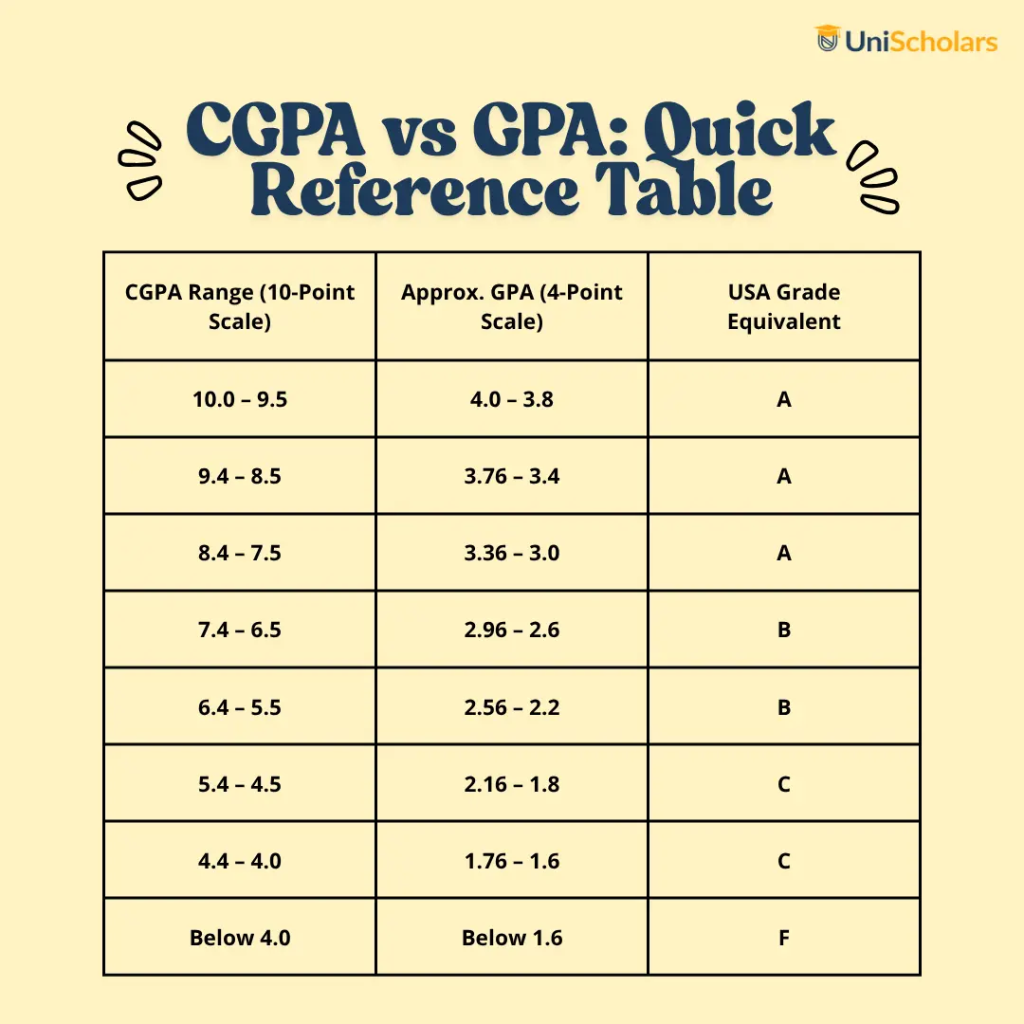Table of Contents
ToggleWhether you are applying to universities abroad, aiming for scholarships, or prepping for global job opportunities, understanding your academic performance in the right format is key. Grading systems vary from country to country, and terms like GPA and CGPA can often be confusing if you are new to them.
In this blog, we break it all down on how to convert a 10-point CGPA to a 4.0-point GPA and also understand what these scores mean, how to convert them, and when the conversion is necessary. We’ll also share how you can use a simple CGPA calculator to save time and avoid mistakes.
CGPA to GPA Converter
Your Result
This is a general estimate based on standard conversion. Actual university evaluations may vary.
⭐ Get Your Free UniScholars Profile Review
We’ve helped 50,000+ students with university shortlisting based on their GPA. Drop your details and our UniScholars expert will help you shortlist universities that match your profile.
High-Five! 🙌
Your GPA is in. Our counsellors will get in touch with you within the next 2 hours to guide you on the best programs tailored to your score!
Something Went Wrong
How To Convert CGPA Into GPA: An Overview
When applying to universities abroad, you will often need to present your grades in a 4-point GPA scale instead of the 10-point CGPA scale used in India and many other countries. To make this easier, a simple conversion formula can give you a close estimate of your GPA.
GPA = (CGPA / Maximum CGPA) * Target GPA scale
What is a CGPA?
CGPA stands for Cumulative Grade Point Average. It is a standardised measure summarising a student’s overall academic performance across multiple subjects, semesters, or the entire degree programme duration. Unlike GPA (Grade Point Average), which typically reflects performance in a single semester or year, CGPA provides a cumulative average of grades earned throughout the academic course, giving a holistic view of a student’s educational achievements.
| CGPA Range | Description |
| 9.1 – 10 | Excellent |
| 8.1 – 9.0 | Very Good |
| 7.1 – 8.0 | Good |
| 6.1 – 7.0 | Above Average |
| 5.1 – 6.0 | Average |
| 4.1 – 5.0 | Below Average |
| 3.3 – 4.0 | Marginal Pass |
| Below 3.3 | Fail |
What is a GPA?
A GPA, or Grade Point Average, is a standard metric for assessing a student’s academic performance. It represents the average of a student’s grades over a specific period be it a semester, academic year, or entire programme. While grading systems may vary globally, the 4.0 scale is the most widely used, especially in the United States. This scale helps institutions evaluate academic standing consistently and comparably.
Here’s a quick breakdown:
| GPA (4.0 Scale) | Letter Grade | Grade Description |
| 4.0 | A | Excellent |
| 3.0 | B | Good |
| 2.0 | C | Average |
| 1.0 | D | Below Average |
| 0.0 | F | Fail |
When and Why Would You Need to Convert CGPA to GPA?
If you are planning to study or work abroad, converting your CGPA to GPA becomes an essential step. Most Indian universities use a 10-point CGPA scale, while universities in countries like the United States, Canada, and others often evaluate applicants using a 4.0 GPA scale. You will likely be asked to convert your grades to ensure your academic performance is accurately assessed.
Here’s when and why this conversion matters:
- University Applications Abroad: Most foreign universities require your grades in the GPA format during the admissions process, especially for undergraduate and postgraduate programmes.
- WES and Credential Evaluations: Agencies like WES (World Education Services) require GPA conversion to standardise international education or employment transcripts.
- Scholarship Applications: Many international scholarships ask for academic qualifications in GPA format to compare global applicants fairly.
- Visa Documentation: Some student visa processes may request academic scores in the GPA system, especially in countries like the USA.
- Academic Benchmarking: Converting CGPA to GPA gives you a clearer idea of how your academic standing compares globally, helping you set realistic expectations and targets.
How to Convert a 10-Point CGPA to a 4-Point GPA?
Many universities abroad, especially in the USA and Canada, use a 4.0 GPA scale, while countries like India often follow a 10-point CGPA scale. If you plan to study abroad, converting your CGPA to GPA is vital for your application.
Basic Conversion Formula:
GPA = (Your CGPA ÷ Maximum CGPA) × Target GPA Scale
For example
Let’s say your CGPA is 8.6 and your college follows the 10-point scale.
To convert it to a 4.0 GPA scale, use the formula:
GPA = (CGPA ÷ Maximum CGPA) × Target GPA scale
GPA = (8.6 ÷ 10) × 4 = 3.44
So, your GPA would be 3.44 out of 4.0
A Step-by-Step Guide To Calculate 10 CGPA to 4 GPA
Since most universities abroad accept scores in GPA format, it’s helpful to know how to convert your 10-point CGPA into a 4-point GPA. Below, we have given a step-by-step guide to calculate 10 CGPA to 4 GPA.
- Check your CGPA on your transcript, which is usually given on a 10-point scale.
- Divide your CGPA by 10 (the maximum CGPA).
- Multiply the result by 4, as 4 is the maximum GPA on the usual US scale.
- The final number is your estimated GPA on the 4-point scale.
CGPA vs GPA: Quick Reference Table

Grading systems can vary, and understanding how your CGPA translates into a GPA can help compare academic performance. The table below provides a simplified reference to see how CGPA on a 10-point scale aligns with GPA on a 4-point scale, along with their general grade equivalents.
| CGPA Range (10-Point Scale) | Approx. GPA (4-Point Scale) | USA Grade Equivalent |
| 10.0 – 9.5 | 4.0 – 3.8 | A |
| 9.4 – 8.5 | 3.76 – 3.4 | A |
| 8.4 – 7.5 | 3.36 – 3.0 | A |
| 7.4 – 6.5 | 2.96 – 2.6 | B |
| 6.4 – 5.5 | 2.56 – 2.2 | B |
| 5.4 – 4.5 | 2.16 – 1.8 | C |
| 4.4 – 4.0 | 1.76 – 1.6 | C |
| Below 4.0 | Below 1.6 | F |
Now that you know how to convert CGPA to GPA, let’s look at the reverse calculation, CGPA from GPA.
How To Calculate CGPA From GPA?
Calculating CGPA from GPA can be useful if you have a GPA score from an international system and want to understand its equivalent on the 10-point CGPA scale commonly used in India.
CGPA = (Your GPA/ 4) ×10
For Example:
If your GPA is 3.6 out of 4, then:
(3.6 ÷ 4) × 10 =9.0
So, your CGPA would be 9.0 out of 10.
Converting CGPA To Percentage
While CGPA is widely used in Indian schools and universities, many institutions, employers, and scholarship bodies in India and abroad still prefer academic scores in percentage format. Whether you are filling out a job application, applying to a university, or submitting documents for a scholarship, you may be asked to convert your CGPA into a percentage. Understanding how this conversion works ensures your academic achievements are accurately represented across different systems.
Basic Conversion Formula:
Percentage = CGPA × 9.5
For Example
If you have a CGPA of 8.4, you can convert it into a percentage by simply multiplying it by 9.5.
Percentage = 8.4 × 9.5 = 79.8%
Global Grading Scale Comparisons
Grading systems vary widely across countries, and understanding these differences is crucial, especially if you are planning to study abroad. While GPA is a standard measure in many places, the scale and structure can differ significantly.
Here’s a quick look at how grading works around the world:
| Country | Grading System | Details |
| USA / Canada | 4.0 GPA Scale | A = 4.0, B = 3.0, C = 2.0, D = 1.0, F = 0.0. Widely used across universities. |
| United Kingdom | Class-based Degree Classification | 1st: ≥70%, 2:1: 60–69%, 2:2: 50–59%, 3rd: 40–49%, Fail: <40% |
| Australia | 7-Point GPA Scale | 7 = High Distinction, 6 = Distinction, 5 = Credit, 4 = Pass, 0–3 = Fail |
| Germany | 1.0–5.0 Scale (Inverted) | 1.0 = Excellent, 2.0 = Good, 3.0 = Satisfactory, 4.0 = Pass, 5.0 = Fail |
Difference Between GPA and CGPA
While GPA (Grade Point Average) and CGPA (Cumulative Grade Point Average) assess academic performance, they differ in scope, scale, and usage.
Here’s a quick comparison to help you understand the key differences:
| Aspect | GPA | CGPA |
| Definition | Average grade points for a semester or term | Average grade points for the entire academic programme |
| Scale | Usually a 4.0 or 5.0 scale | Often a 10-point scale (varies by country) |
| Usage | Common in the US and many Western countries | Common in India, Singapore, and some other countries |
| Calculation | Based on grades in courses per semester | Based on all semesters combined |
| Purpose | Reflects performance in a specific term | Reflects overall academic performance |
Tips for Accurate Conversion From CGPA To GPA
Converting CGPA to GPA (or vice versa) isn’t just about applying a formula; it requires a solid understanding of grading systems, institutional policies, and calculation precision. Here are some key tips to ensure an accurate conversion:
- Understand the Grading Scale Used
- Identify the exact scale your institution follows, e.g., CGPA out of 10 or GPA out of 4.
- Check if the system is linear or nonlinear; some universities have uneven grade intervals that affect how scores translate.
- Use Official University Guidelines
- Many universities publish conversion charts or recommended formulas.
- Always check the official website or admission handbook to avoid relying on generalised or inaccurate conversions.
- Be Cautious with Formulas
A commonly used formula is: GPA = (CGPA ÷ 10) × 4
For example, if your CGPA is 8.2 out of 10:
GPA = (8.2 ÷ 10) × 4 = 3.28
Note: This method gives an estimate and may not align with how every university evaluates academic scores. Always cross-check with official resources or evaluators.
- Factor in Credit Hours and Weightage
- Some institutions weigh courses differently based on credit hours or difficulty.
- When converting, ensure you account for course weightage to reflect academic performance accurately.
- Avoid Rounding Too Early
- Always perform calculations using full decimal values.
- Only round the final result if the institution requires it (e.g., to two decimal places).
- Consult Evaluation Experts for High-Stakes Applications
- For university admissions or visa purposes, consider using credential evaluation services like WES.
- Alternatively, speak to your academic advisor for case-specific guidance.
Wrapping Up!
Converting your 10-point CGPA to a 4-point GPA doesn’t have to be intimidating. Once you understand how they work and when to convert between them, you will be better prepared for international applications, scholarship forms, and even visa interviews. Whether calculating your percentage, translating your CGPA to a 4.0 GPA, or benchmarking against global standards, this knowledge gives you the clarity and confidence to present your academic achievements accurately.
Let UniScholars guide you every step of the way from choosing the right university to acing your applications and securing scholarships. Our expert counsellors can help you make sense of your GPA, CGPA, and everything in between so you can focus on what truly matters: your future.
FAQs
Q. Is CGPA and GPA the same?
Ans: No, CGPA and GPA are not the same. GPA (Grade Point Average) typically reflects performance in a single semester or year, while CGPA (Cumulative Grade Point Average) represents the overall average across all semesters or academic years in a course.
Q. How to convert 10 CGPA into 4 GPA?
Ans: To convert a 10-point CGPA to a 4-point GPA, use the formula: GPA = (CGPA ÷ 10) × 4.
For example, a CGPA of 8.5 would be equivalent to a GPA of 3.4 on a 4-point scale.
Q. What is 9.7 CGPA in percentage?
Ans: To convert a CGPA of 9.7 into a percentage, multiply it by 9.5.
So, 9.7 × 9.5 = 92.15%, which means your percentage is 92.15%.
Q. What is a CGPA to GPA calculator?
Ans: A CGPA to GPA calculator is an online tool that helps students convert their 10-point CGPA (commonly used in countries like India) into a 4-point GPA system, which is standard in countries like the USA and Canada. It uses a simple formula usually (CGPA ÷ 10) × 4 to give an approximate GPA score for international applications.

















1 thought on “Top PGDM Courses In Canada: Universities & Eligibility”
I have done Bachelor’s in Culinary Arts from India and completed my graduation in the year 2022 .I am 22 years old. After graduation, I have done 1 year paid internship from USA .Now, I would like to take occupational experience and learn culinary skills and also do masters in Culinary arts.How can I find the college n best course / country where I can persue studying further